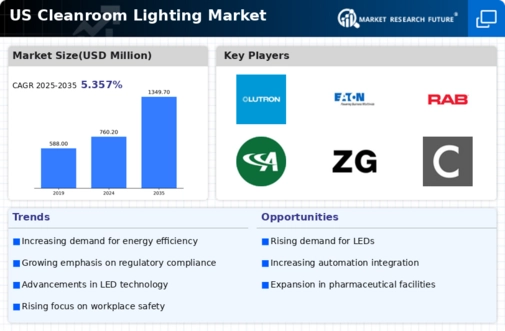The US Cleanroom Lighting Market has witnessed significant dynamics driven by increasing regulatory requirements and the growing need for precision in industries such as pharmaceuticals, biotechnology, and electronics manufacturing. In such controlled environments, the demand for specialized lighting solutions that maintain cleanliness and quality standards has become paramount. The competitive landscape is evolving rapidly, with companies innovating their products to enhance energy efficiency and improve worker safety.
The market includes a blend of both emerging players and established industry giants, each striving to differentiate themselves through advanced technologies and robust service offerings that cater specifically to the unique demands of cleanroom environments. Companies in this sector are not only competing on product specifications but also on customization abilities to meet specific client needs, thus fostering an environment of continuous innovation.Lutron Electronics holds a prominent position in the US Cleanroom Lighting Market, leveraging its deep expertise in lighting control solutions to cater specifically to cleanroom environments.
Known for its advanced dimming technologies and energy-efficient lighting systems, Lutron Electronics emphasizes user control and flexibility, which are critical in cleanroom settings where lighting conditions may need to be adjusted based on specific tasks. The company's strengths lie in its commitment to quality and reliability, ensuring that its products help maintain the stringent standards of cleanliness required in such environments.
By focusing on customizable lighting solutions, Lutron Electronics has successfully carved out a niche within the market, providing clients with tailored solutions that effectively enhance operations while reducing energy consumption.Philips Lighting has made a significant impact in the US Cleanroom Lighting Market through its commitment to innovation and sustainability.
With a comprehensive portfolio that includes LED lighting solutions, sensors, and control systems, Philips Lighting is well-positioned to address the rigorous demands associated with cleanroom applications. The company’s strengths include its robust research and development capabilities which enable the introduction of state-of-the-art lighting technologies that prioritize both performance and energy efficiency. Philips Lighting has also engaged in strategic mergers and acquisitions to broaden its market footprint and enhance its product offerings within the cleanroom segment.
Through these strategies, the company is not only enhancing its market presence but also reinforcing its position as a key player in delivering solutions that meet the evolving needs of cleanroom operations across various industries in the US.

















